Service plan defines Call Rating details for all available destinations but it will also enable you to create a template for enhanced services, destinations and Online Self Care settings that will be automatically applied to extensions associated with service plan.
NOTE: Using Service Plan is not obligatory but is recommended as it enhances the customer experience.
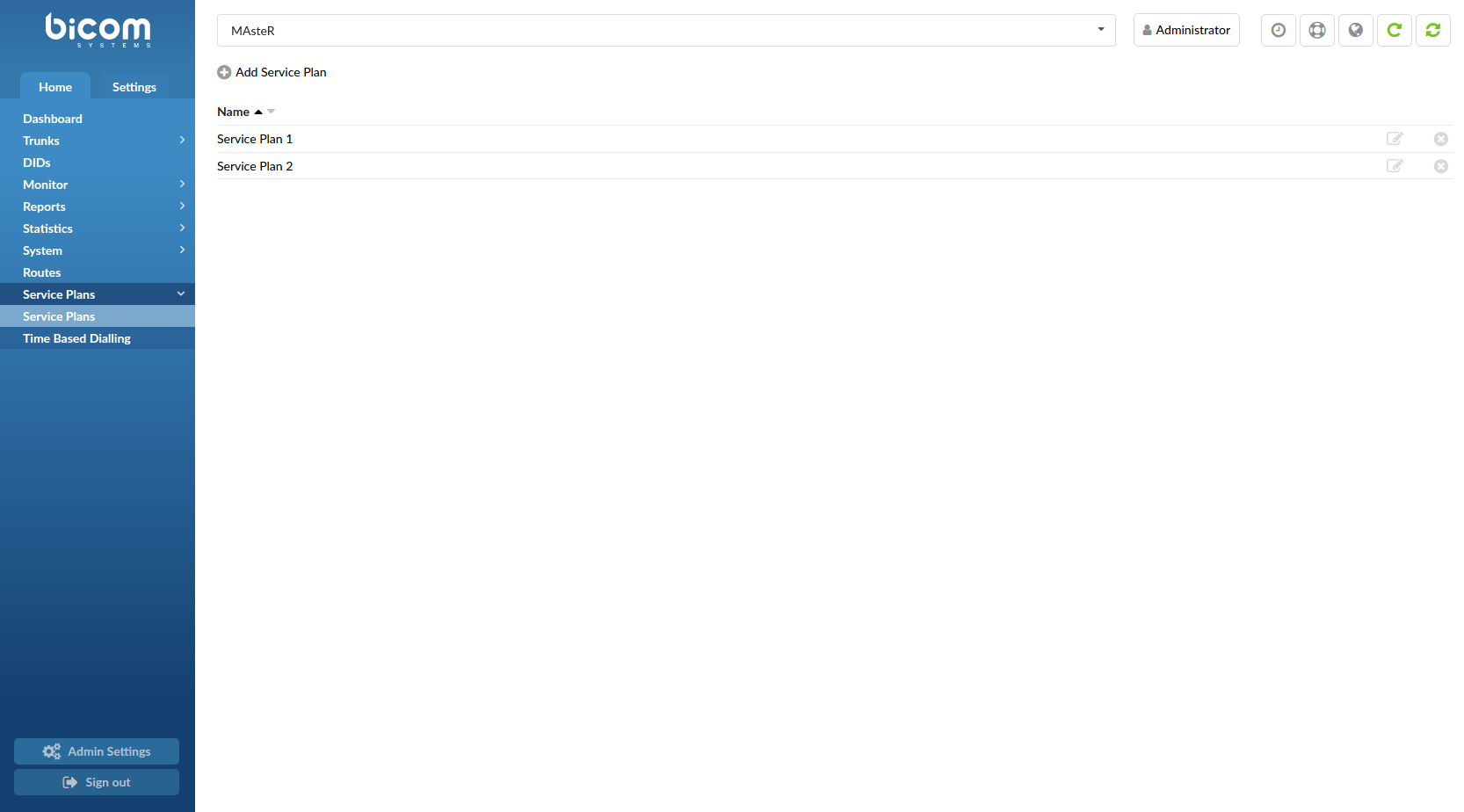
¶ Service Plans

This screen lists all Service Plans with the following details
- Name:
Service plan name
(E.g. Euro)
(Display)
 Edit
Edit
Edits the service plan
(Button)
 Delete
Delete
Deletes a service plan from the system
(Button)
¶ Add/Edit Service Plan
These options fine tune the service plan with details such as minimum and connection charge, grace period, and inclusive minutes
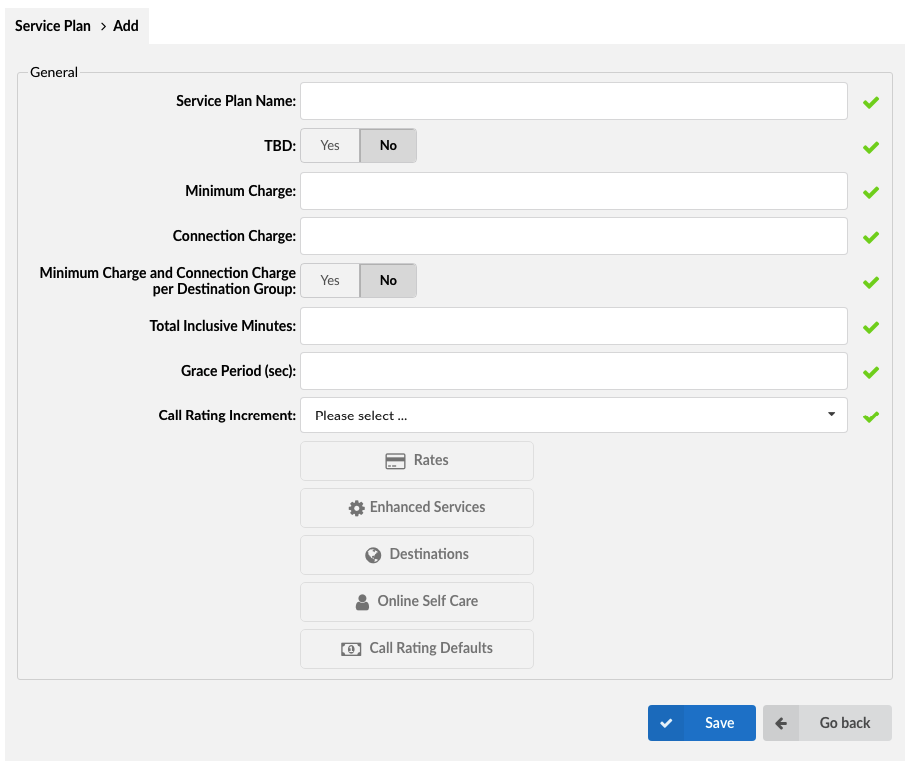
- Service Plan Name:
Service plan name
([a-z][0-9])
- TBD:
Should Time Based Dialing be applied to the current Service Plan
Time Based Dialing is used in case users want to charge calls differently depending on the period of time. For example, users can set different prices for mornings or weekends, etc.
(Option buttons)
- Minimum charge:
Minimum charge applied to each made call regardless of the call duration
If call is made, no matter how much it lasts, this "minimum charge" will be applied.
NOTE: If "Grace period" is set, "Minimum charge" will be applied after the grace period expires.
([0-9])
- Connection charge:
Charge applied to any call that leaves the system (only if other party answers)
(E.g. If connection charge is set to 0.4, each call that leaves the system will be charged that amount after the other party answers the call.)
NOTE: If both "Connection charge" and "Minimum charge" are set, sum of them will be charged after the other party answers the call. This sum will not be charged immediately if "Grace period" is set.
([0-9])
- Connection Charge per Destination Group:
If this option is set to "Yes", user can define Minimum charge and Connection charge per Destination Group. If this option is set to "No", Minimum charge and Connection charge will be applied from Service plan.
- Total Inclusive Minutes:
Total number of inclusive (free) minutes assigned to a service plan.
(E.g. If the value of this field is set to "5", each user extension assigned to this service plan will have 5 free (inclusive) minutes of call time to a location to which inclusive minutes apply)
([0-9])
NOTE: "Minimum charge" and "Connection charge" will be applied if set.
- Grace Period:
Defines how many seconds short calls will not be charged.
(E.g. if grace perios is set to 10, every call that lasts 10 seconds or less will not be charged. Note that call which lasts more than 10 seconds will be charged.)
([0-9])
- Call Rating Increment:
Call Rating type (MINIMUM_CHARGED/CHARGE_EVERY_$SECONDS)
Select how the call will be rated. First number is how many seconds will be charged immediately after the beginning of a call, the second number is at which rate call will be charged after the time from first number expires.
(E.g. If "30/6" is selected, and you have made the call which lasted 12 seconds, it will be billed as if you have made a 30 seconds call. If the call lasted for 39 seconds - it will be billed as if the call lasted 42 seconds (30 + 6 + 6 = 42))
(Select box)
¶ Rates
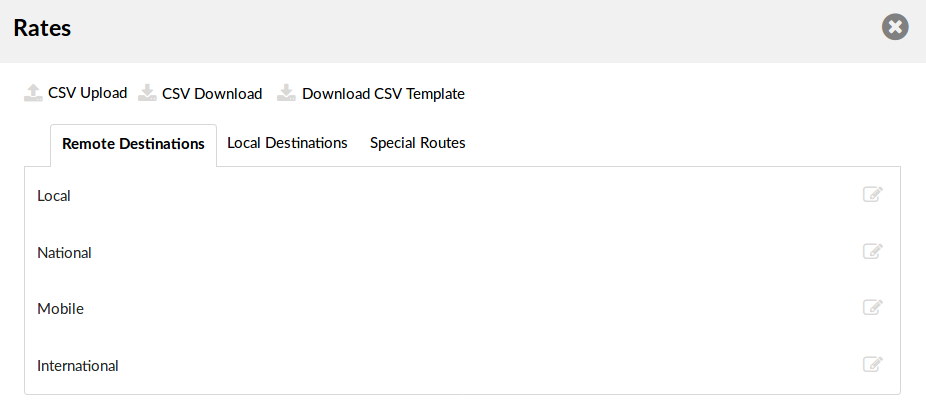
These options set incoming/outgoing rates per each known destination. NOTE: If TBD is set to "Yes", in order to edit Rates user should first create TBD rule in Service Plans -> Time Based Dialing.
Depending on Routing mode, which is set on Master tenant -> Tenants -> General Settings -> Routing mode, "Rates" section is slightly different if routing mode is set to E.164 routing than when set on Simple routing.
For E.164 routing:
¶ CSV Upload/Download
Destination Group rates can be easily uploaded and downloaded from the server. Update the .CSV file on your desktop, click on "Browse" button, select the file and click on the "Upload" button.
TIP: CSV file must be in the following format ("Code","Route","Destination","Outbound","Inbound", "Inclusive", "Call Rating", "Minimum Charge", "Connection Charge"). For example (93,"Afghanistan","mobile")
To download rates file from the server just click on "Download CSV" button.
¶ Download CSV Template
Here you can download CSV Template which already contains necessary headers that can help you with creating CSV file easier.
¶ Routes
Click on a letter under a "Routes" navigation "A" for example and select "Australia". A list of "Destination Groups" will be displayed under "Destination Group". Click on the "Edit" button to edit the Destination Groups charges.
TIP: If Time Based Dialing is turned on, you will enter charging for all TBD rules.
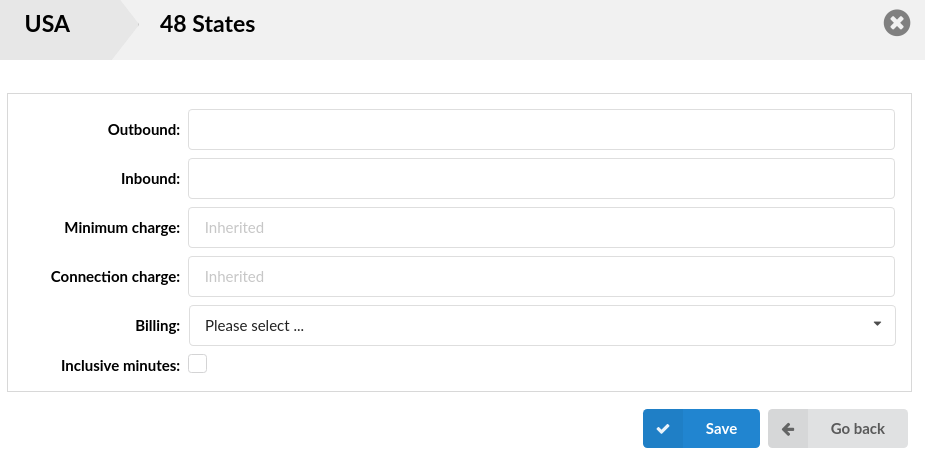
- Outbound:
Destination group outbound charge
(E.g. If you edit the "Mobile" destination group and set this option to 5.00000, this rate will be applied to all calls made to Mobile destination)
([0-9])
- Inbound:
Destination group inbound charge
(E.g. If you edit the "Mobile" destination group and set this option to 5.00000, this rate will be applied to all calls made to "Mobile" destination)
([0-9])
- Minimum charge:
Minimum charge for this destination group.
If call is made, no matter how much it lasts, this "minimum charge" will be applied.
- Connection charge:
Connection charge for this destination group. It is applied to a call that leaves the system (only if other party answers).
- Call Rating:
Select call rating type for this destination.
First number is how many seconds will be charged immediately after the beginning of a call, the second number is at which rate the call will be charged after the time from first number expires.
(E.g. If "30/6" is selected, and you have made the call which lasted 12 seconds, it will be billed as if you have made a 30 seconds call. If the call lasted for 39 seconds - it will be billed as if the call lasted 42 seconds (30 + 6 + 6 = 42).)
- Inclusive minutes:
Should inclusive minutes be calculated for this destination
(Option buttons)
¶ For Simple Routing
All fields are more or less the same as for E.164 routing. The only difference is that the format of CSV file should now be: ("Route name", "Outbound", "Inbound", "Inclusive minutes", "Billing", "Minimum charge", "Connection charge").
¶ Enhanced Services
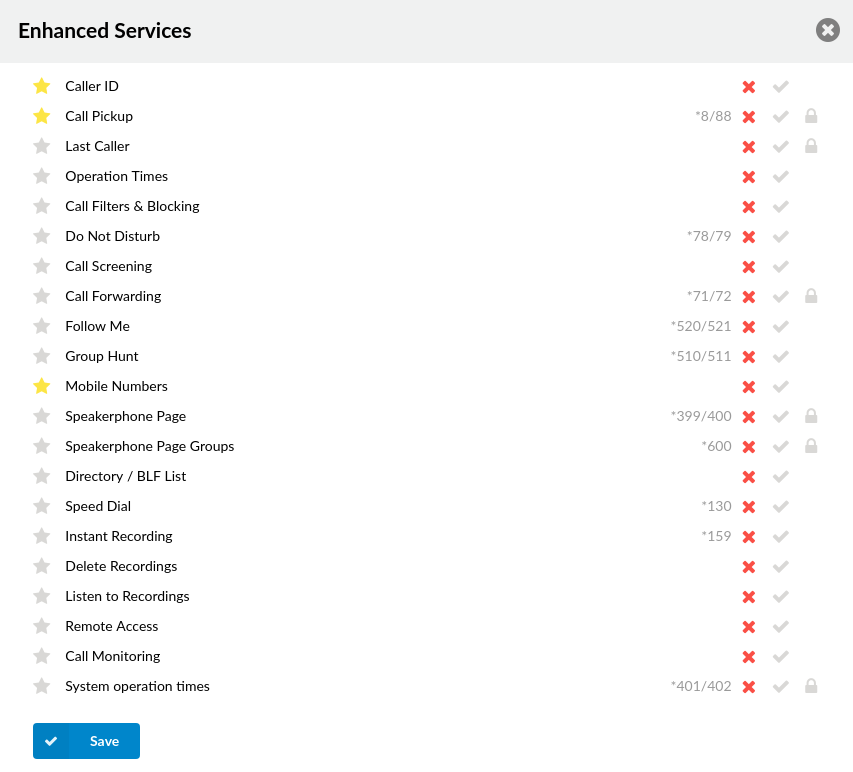
Enhanced Services set here will be applied to all users assigned to this Service Plan. For example, if the "Euro" Service Plan is set to have only "Call Forwarding" enabled, all users with the "Euro" Service Plan will have "Call Forwarding" enabled only.
- When creating service plan default enhanced services can be selected, by selecting a star symbol next to service, which will be available in OSC for the end user.
For more on Enhanced Services, please click the link below: Enhanced Services
¶ Destinations
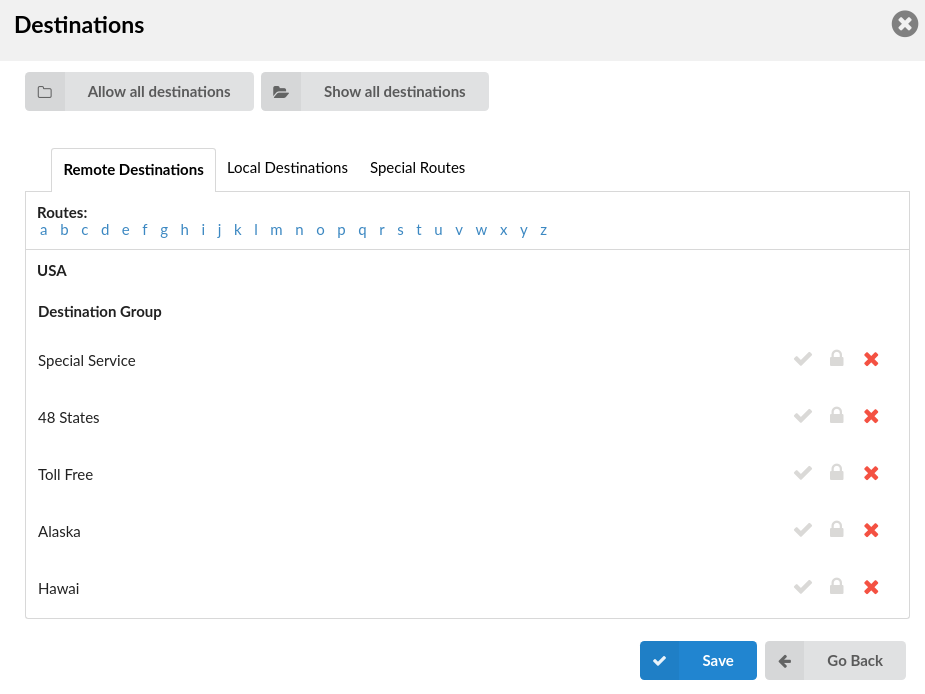
Destinations set here will be applied to all users assigned with this Service Plan. This section makes it possible for users to allow or not allow some destination. Also, here users can set "PIN Required" destinations, so when calling them user will be prompted for a PIN. For example, if the "Euro" Service Plan is set to have the "UK: Proper" destination allowed only, all users with "Euro" Service Plan will be able to call only "UK: Proper"
- Allow all destinations
Allows all destinations for this Service Plan.
(Button)
- Show allowed destinations
Shows all destination user allowed.
NOTE: PIN Required destinations will not be shown.
(Button)
¶ Online Self Care
This option enables users to choose which options will be shown in Online Self Care of extensions to which this Service plan is applied to.

- Show voicemail
Whether to show the voicemail option in OSC of extensions covered by this Service Plan.
(Check box)
- Show Enhanced Services
Whether to show Enhanced Services in OSC of extensions covered by this Service Plan.
(Check box)
- Show destination permissions
Whether to show allowed destinations in OSC of extensions covered by this Service Plan.
(Check box)
¶ Call Rating Defaults
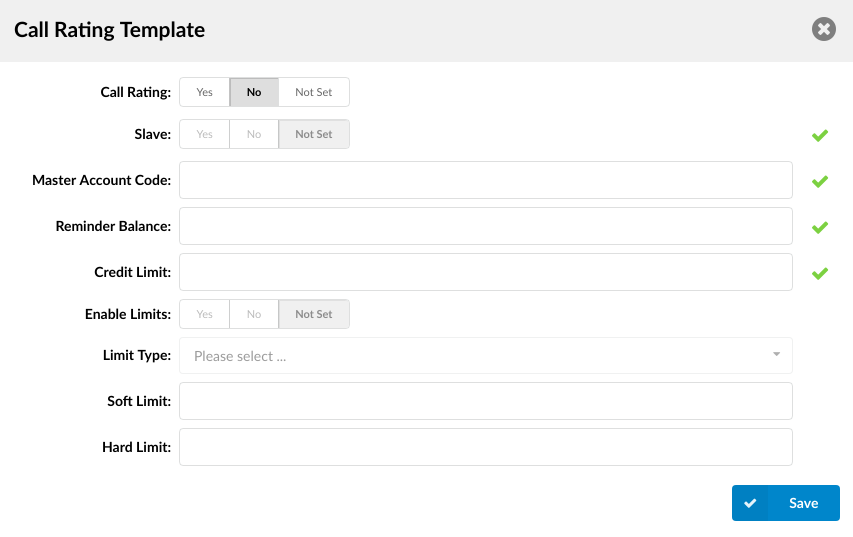
¶ Call Rating Defaults
Call Rating Template
NOTE: The default Call Rating template on Service Plan will be used only when users, without privileges to set and control Call Rating, create new Extensions.
- Call Rating:
Enable Call Rating by using the template.
(E.g. Yes, No, Not Set)
(Option buttons)
- Slave:
Set two Extensions to share the same call rating funds.
(E.g. Yes, No, Not Set)
(Option buttons)
- Master Account Code:
If the previous "Slave" field is set to "Yes", here users should enter the Master Extension Number from which the funds will be used.
(E.g If the Extension 1000 is a Master Extension and has 100.00 of credit, and we want the Slave Extension 1001 to use these funds, we need to set 'Master Account Code'='1000'. Now, any calls made by these two Extensions will take the credit off of the Extension 1000.)
([0-9])
- Reminder Balance:
Set the account balance amount at which a reminder should be sent to the user.
If this field is set to 10, the user will receive an e-mail notification when the account balance reaches 10.
NOTE: This option is available if "Slave" is set to "No/Not Set".
([0-9])
- Credit Limit:
Set the maximum amount that the system will extend to the Call Rating account.
If this field is set to '10' and the account balance has dropped down to "0", the account will still have "10" units in available funds.
NOTE: This option is available if "Slave" is set to "No/Not Set".
([0-9])
- Enable Limits:
Set the limits to one of the following options: 'Yes', 'No', 'Not Set'.
NOTE: This option is available if "Slave" is set to "No/Not Set".
(Option buttons)
- Limit Type:
Set the limits to be applied 'Daily' or 'Monthly'.
NOTE: This option is available if "Slave" is set to "No/Not Set" and "Enable Limits" is set to "Yes".
(Select box)
- Soft Limit:
Depending on the 'Limit Type', when the Extension reaches a Soft Limit, the e-mail will be sent to the person in charge of Call Rating.
(E.g. Set 10 here, if you want an e-mail sent when the user hits that amount when calling.)
NOTE: This option is available if "Slave" is set to "No/Not Set" and "Enable Limits" is set to "Yes".
([0-9])
- Hard Limit:
Depending on the 'Limit Type', when the Extension reaches 'Hard Limit', the system will block this Extension from making any further calls.
(E.g. Set 20 here, if you want the system to block this Extension from making any calls when the user hits that amount when calling.)
NOTE: This option is available if "Slave" is set to "No/Not Set" and "Enable Limits" is set to "Yes".
([0-9])
¶ Time Based Dialing
Time Based Dialing is a feature which enables call charging by specific TBD rules. These rules specify the date/time for which they apply. When entering Rates in Service Plans with enabled TBD, you will be able to enter price rates for every specified TBD rule.

- Rule name
TBD rule name
(E.g. Working hours)
(Display)
- Priority
Priority of TBD rule. The lower the number the higher the priority.
(E.g. 5)
(Display)
 Edit
Edit
Edits the TBD rule
(E.g. Click to edit the TBD rule)
(Button)
 Delete
Delete
Deletes the TBD rule
(E.g. Click to delete the rule)
(Button)
¶ Add TBD rule
These options are used for adding/editing specific TBD rules
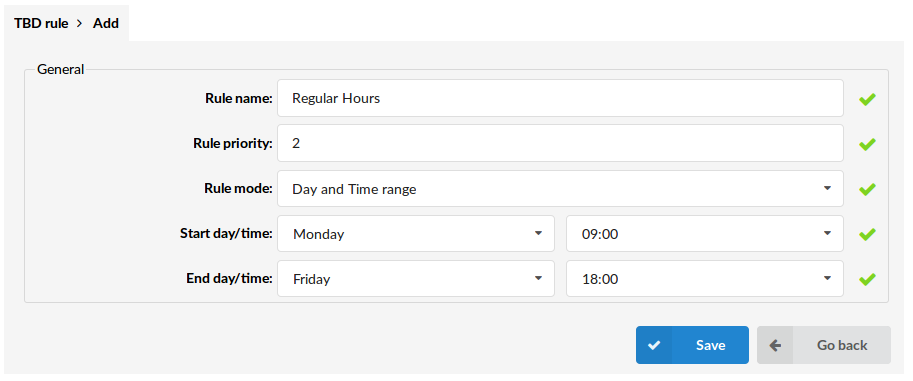
- Rule name:
TBD rule name
(E.g. Working hours)
([a-z][0-9])
- Rule priority:
This field defines priority of the TBD rule. If dates or times of two or more rules are overlapping, the rule with the higher priority is taken.
The lower the number the higher the priority.
(E.g. 5)
([0-9])
- Rule mode:
Depending on the rule mode, the TBD rule can be set as a:
- Day/Time split range
- Day and Time range
- Date range
(Select box)
Day/Time split range
- Day range (beginning):
Beginning day of the day range for which the TBD rule applies.
(E.g. Monday)
(Select box)
- Day range (ending):
Ending day of the day range for which the TBD rule applies.
(E.g. Sunday)
(Select box)
- Time range (beginning):
Beginning of the time range for which the TBD rule applies.
(E.g. 00:00h)
(Select box)
- Time range (ending):
Ending of the time range for which the TBD rule applies.
(E.g. 23:00h)
(Select box)
Day and Time range
- Start day/time
Beginning day and time of the time range for which the TBD rule aplies.
(E.g. Monday 08:00h)
- End day/time
Ending day and time of the time range for which the TBD rule applies.
(E.g. Friday 17:00h)
Date range
- Date range:
Pick start and end date on the calendar in which the TBD rule applies.
(E.g. 03 Sep 2019 - 06 Sep 2019)
(Buttons)